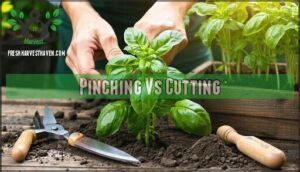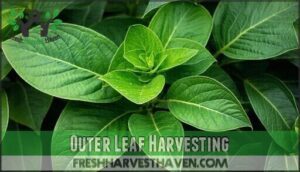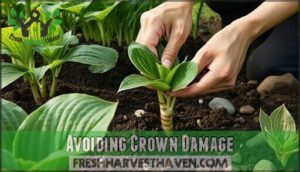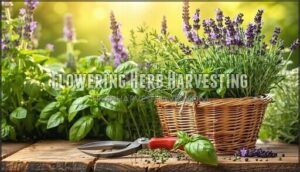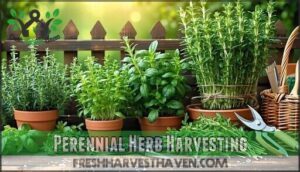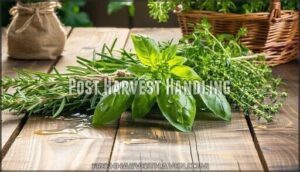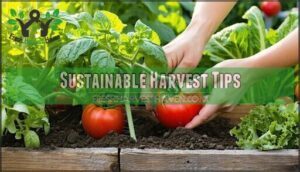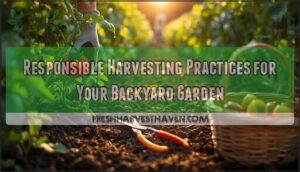This site is supported by our readers. We may earn a commission, at no cost to you, if you purchase through links.
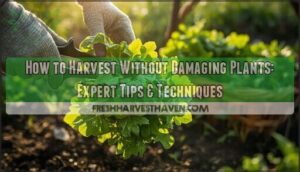
Cut stems just above leaf nodes or growth points using scissors or pruning shears – never tear or pull.
For leafy greens, harvest outer leaves first, leaving the growing center intact. Take no more than one-third of the plant at once, allowing it to recover and continue producing.
Water plants beforehand to guarantee they’re hydrated and less stressed during harvesting. The best time is early morning when plants are fully hydrated but before the day’s heat sets in.
Master gardeners know that gentle handling preserves both plant health and future harvests, ensuring a successful and continuous production with proper care.
Table Of Contents
- Key Takeaways
- Harvesting Basics
- Harvest Without Damage
- Herb Harvest Methods
- Post Harvest Handling
- Sustainable Harvest Tips
- Frequently Asked Questions (FAQs)
- How to harvest herbs without killing the plant?
- How to properly harvest plants?
- What can ruin a harvest?
- What is the sustainable harvesting method?
- How do you harvest herbs?
- Can you harvest cilantro without killing it?
- What is harvesting a plant & why is it important?
- Why is harvesting herbs important?
- How do you harvest Basil without killing it?
- When should I Harvest my herbs?
- Conclusion
Key Takeaways
- Use sharp, clean tools like pruning shears or scissors to make precise cuts above leaf nodes – you’ll prevent disease spread and encourage healthy regrowth
- Harvest only outer leaves first and never take more than one-third of the plant at once – you’ll keep the growing center intact for continuous production
- Time your harvests for early morning when plants are fully hydrated but before heat stress sets in – you’ll get maximum flavor and minimize plant damage
- Cut stems just above growth points rather than pulling or tearing – you’ll protect the plant’s structure and ensure it can recover quickly for future harvests
Harvesting Basics
You’ll want to understand how your herbs grow before you start harvesting to avoid damaging their natural patterns and structures.
The right tools and timing make all the difference between a thriving garden and stressed plants that struggle to recover.
Herb Growth Habits
Understanding herb growth cycles helps you harvest without harming your plants.
Different herbs have unique growth patterns that affect when and how you should harvest them.
- Annual herbs like basil complete their Growth Cycles in one season
- Perennial herbs such as rosemary return year after year with proper plant care tips
- Biennial herbs like parsley produce leaves first year, flowers second
- Fast-growing herbs need frequent harvesting to prevent bolting
- Slow growers require patience but reward gentle harvesting with intense flavors
To maximize yields, mastering proper harvesting techniques for each herb type is vital.
Tools and Techniques
Sharp pruning tools make all the difference in gentle harvesting. Clean shears prevent disease spread between plants. Gardening gloves protect your hands while maintaining dexterity for precise cuts.
Proper gardening shears maintenance is essential for effective harvesting.
| Tool | Best For | Cutting Technique | Benefit |
|---|---|---|---|
| Harvest Shears | Thick stems | Clean snip | Prevents crushing |
| Kitchen Scissors | Delicate herbs | Precise cuts | Minimizes damage |
| Pruning Snips | Woody branches | Angled cuts | Promotes regrowth |
| Fingers | Soft leaves | Gentle pinch | Natural harvest |
The use of the right tool, such as harvest shears or kitchen scissors, can greatly impact the quality of the harvest, making it a crucial aspect of gardening to master proper tool maintenance and handling techniques.
Harvest Timing
Timing makes or breaks your harvest. Watch for ripeness checks like color changes and firmness to nail your ideal harvest time.
Early morning harvesting preserves water content and reduces bruising. Monitor your crop yield potential through seasonal planning and harvest schedules.
Smart timing strategies boost plant handling success while maximizing results from your harvesting methods, which is crucial for a successful harvest.
Harvest Without Damage
You’ll want to harvest your herbs carefully to keep them healthy and producing all season long.
The right techniques protect the plant’s growth points while giving you the fresh herbs you need for cooking.
Pinching Vs Cutting
Pinch methods work best for tender growth on young plants, while cutting tools handle mature stems.
When you pinch soft herbs like basil above a node, you’re encouraging bushier growth without stress.
Save your sharp cutting tools for woody stems or larger harvests.
Both harvesting techniques protect plants when done right.
Pinching removes just the tips with your fingers, promoting lateral branching.
Cutting requires clean, sanitized tools to prevent disease.
Choose your plant handling method based on stem maturity and your harvest goals.
Understanding proper herb pinching techniques is essential for a healthy harvest.
Outer Leaf Harvesting
Start with the oldest leaves when selecting what to harvest.
Outer leaf harvesting means choosing mature leaves on the plant’s perimeter first. This leaf selection strategy protects younger inner growth while giving you the best foliar harvest.
Use stem cutting techniques that leave the growing center intact. These nondamaging harvest methods follow proper harvesting guides for sustained crop protection.
Avoiding Crown Damage
Never harvest at the plant’s heart or growing point.
This crown protection strategy keeps plants producing for months.
Use gentle plant handling when working near the base.
Your nondamaging harvest techniques should focus on outer growth while preserving the central stem care area.
Root preservation happens naturally when you avoid disturbing soil around the crown.
Smart damage prevention means healthier plants, and this is achieved through careful handling and gentle care, ensuring the central stem is protected.
Herb Harvest Methods
Different herb types need specific harvesting methods to keep your plants healthy and productive.
You’ll use gentle techniques for leafy herbs, time flowering herbs perfectly, and manage perennials for long-term growth.
Leafy Herb Harvesting
Leafy herbs’ tender foliage requires gentle handling during your leaf harvest sessions. Smart herb pruning preserves plant health while maximizing your green cutting yields. Proper harvest techniques protect growing points and encourage continuous production.
Effective herb harvest tools, such as those found in Herb Harvest, are essential for a successful harvest.
- Harvest outer leaves first – maintains plant nourishment flow to inner growth
- Cut above leaf nodes – promotes new shoot development for future harvests
- Take only one-third – prevents stress while supporting ongoing herb care
- Use clean, sharp scissors – reduces crop damage and disease transmission
Flowering Herb Harvesting
Flowering herbs like basil and lavender reach peak flavor just as buds form but before they open.
This harvest time delivers maximum essential oils for both culinary use and floral arrangements.
Use clean, sharp pruners for herb pruning to prevent disease transmission. Cut stems above leaf nodes to encourage bushier growth and avoid blossom removal damage.
To guarantee maximum growth and flavor, following the golden rule guidelines for harvesting herbs is vital.
| Harvest Timing | Plant Response |
|---|---|
| Just before bloom | Peak oil concentration |
| Early morning | Maximum flavor retention |
| After dew dries | Prevents mold formation |
| Regular pinching | Doubles flower yield |
Perennial Herb Harvesting
Perennial herbs need careful handling since they’ll keep producing for years.
Cut stems one-third back during herb pruning, leaving enough foliage for strong plant regrowth. Target outer growth first during leaf harvest to protect the crown.
Sharp, clean tools prevent disease while supporting proper stem care. Time your crop management around peak morning hours for best botanical care and root preservation.
Understanding proper harvesting methods is essential for maintaining healthy perennial herbs with proper stem care and best botanical care.
Post Harvest Handling
After you’ve carefully harvested your herbs, proper handling becomes essential for preserving their quality and potency.
You’ll want to clean, dry, or freeze them quickly to lock in their fresh flavors and prevent spoilage.
Cleaning Herbs
After harvest, you’ll need to clean your herbs properly.
Herb sanitizing starts with gentle washing under cool running water.
Herb rinsing removes dirt and debris effectively.
Hold leafy herbs by their stems while washing – this prevents bruising.
Leaf cleaning works best when you swish herbs gently in a bowl of cold water.
Change the water until it runs clear.
Pat herbs dry with paper towels for fresh storage, ensuring they are properly cleaned and ready for use with gentle care.
Drying Methods
Once you’ve cleaned your herbs, proper drying methods will determine how well your harvest timing and plant protection efforts pay off. Smart drying preserves flavors and extends shelf life substantially.
Here are three proven drying methods:
- Air Drying – Bundle 4-6 stems and hang upside down in a well-ventilated area for 1-3 weeks. This gentle method preserves essential oils perfectly.
- Oven Drying – Spread leaves on parchment paper and dry at 40-60°C for 1-2 hours. Turn halfway through for even results.
- Dehydration Tips – Use food dehydrators at low temperatures to maintain herb curing quality while speeding the process.
Each method affects crop preservation differently, so choose based on your herb type and available time. For superior results, understanding herb drying techniques is vital to preserve the herbs’ potency and flavor.
Freezing Herbs
Blanching herbs before freezing locks in their vibrant color and fresh taste.
Simply dip clean herbs in boiling water for thirty seconds, then plunge into ice water.
Pat dry and use flash freezing on baking sheets before transferring to containers.
This herb preservation method maintains quality for months, making frozen storage ideal for crop preservation and sustainable gardening practices.
Sustainable Harvest Tips
Beyond harvesting techniques, maintaining healthy plants requires ongoing care that supports future growth.
You’ll need to focus on soil nutrition, natural pest management, and clean growing conditions to keep your garden productive season after season, which is essential for future growth.
Organic Fertilizers
Organic fertilizers fuel your plants’ long-term health while supporting sustainable gardening practices.
Compost tea delivers gentle nutrients that boost crop yields without burning roots.
Natural amendments like vermicompost and biodynamic farming preparations enrich soil structure over time.
These eco friendly fertilizer options create robust plant care systems that reduce environmental impact while maintaining productive harvests through thoughtful organic farming methods.
Pest Control Methods
Smart pest management protects your plants during harvest season. Biological Control works like nature’s security team – beneficial insects patrol your garden while Organic Pesticides provide backup when needed.
- Release ladybugs and lacewings for natural aphid control
- Apply neem oil or pyrethrin-based sprays for immediate relief
- Set up Pest Traps to monitor and reduce flying insects
- Use Crop Rotation to break pest life cycles
- Install row covers as physical barriers during vulnerable growth periods
These methods maintain plant health while supporting soil health for sustainable crop maintenance.
Garden Hygiene Tips
Your garden’s cleanliness directly impacts plant health and harvest success. Maintaining proper hygiene prevents disease spread and supports robust growth through simple yet effective practices.
| Hygiene Practice | Impact on Plant Health |
|---|---|
| Sanitized Tools | Prevents pathogen transmission between plants |
| Clean Gloves | Reduces contamination during handling |
| Sterile Equipment | Maintains water quality and soil health |
Smart gardening methods include cleaning harvest containers between uses and removing plant debris promptly, utilizing effective disease control methods to minimize the risk of infection. These eco friendly gardening practices boost crop maintenance while supporting long-term garden maintenance success.
Frequently Asked Questions (FAQs)
How to harvest herbs without killing the plant?
Cut herbs using sharp, clean pruners in early morning. Harvest only one-third of the plant, leaving stems with several leaf nodes intact for continued growth.
How to properly harvest plants?
Like tending a garden requires gentle hands, you’ll want to harvest with care and precision.
Use sharp, clean tools and cut stems at angles during cool morning hours.
Avoid pulling or twisting plants, which damages roots and reduces future yields, to ensure gentle handling and precision in your gardening techniques.
What can ruin a harvest?
Heavy rain, extreme heat, pests, diseases, improper timing, and rough handling can destroy your harvest.
You’ll lose crops to weather damage, insect infestations, fungal infections, premature picking, or careless collection methods that bruise produce, due to issues like rough handling.
What is the sustainable harvesting method?
Sustainable harvesting uses rotational picking schedules, allowing plants adequate recovery time between harvests. You’ll boost yields by 10-15% while maintaining plant health through strategic timing and gentle techniques.
How do you harvest herbs?
You’ll harvest herbs by cutting stems early morning using sharp, clean scissors about one-third above the soil.
Choose mature leaves, snip just above leaf nodes, and avoid pulling to prevent root damage.
Can you harvest cilantro without killing it?
You can harvest cilantro without killing it by cutting outer leaves with sharp, clean scissors about one inch above soil level.
Leave the center growing point intact so new leaves will continue sprouting for future harvests throughout the season.
This allows you to continue harvesting cilantro.
What is harvesting a plant & why is it important?
You’re not just randomly cutting plants – harvesting means strategically removing mature parts like fruits, leaves, or seeds at prime times.
It’s vital because proper timing maximizes nutrition while keeping plants healthy for continued growth, and harvesting is a process that requires careful consideration.
Why is harvesting herbs important?
You’ll boost your garden’s productivity by harvesting herbs regularly, which encourages new growth and prevents flowering that reduces leaf quality and flavor intensity.
How do you harvest Basil without killing it?
A pinch of prevention beats a pound of cure"—harvest basil by pinching just above leaf pairs, not cutting the main stem.
You’ll encourage bushier growth while keeping your plant thriving for continuous harvests throughout the season.
When should I Harvest my herbs?
You’ll know it’s time when herbs reach their peak flavor just before flowering begins. Pick early morning after dew dries for maximum essential oils and freshness.
Conclusion
Practice makes perfect when learning how to harvest without damaging plants, and your garden will reward your careful approach.
You’ve discovered that timing, proper tools, and gentle techniques protect plant health while maximizing yields.
Remember to cut above growth nodes, harvest outer leaves first, and never take more than one-third at once.
These methods guarantee continuous production throughout the growing season.
Your plants will thrive with this knowledge, providing fresh harvests for months to come.
- https://chicagolandgardening.com/gardening-techniques/plant-care/how-to-harvest-herbs-without-killing-the-plant/
- https://www.chefsresource.com/how-to-harvest-herbs-without-killing-the-plant/
- https://www.almanac.com/video/12-helpful-harvesting-hacks-and-hints
- https://heybigsplendor.com/how-to-harvest-herbs-without-killing-the-plant/
- https://www.bobvila.com/articles/how-to-harvest-herbs/

